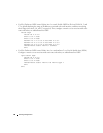
Routing Configuration 95
Route Preferences
You can use route preference assignment to control how the router chooses which routes to use when
alternatives exist. This section describes three uses of route preference assignment:
• "Assigning Administrative Preferences to Routing Protocols" on page 95
• "Using Equal Cost Multipath" on page 97
Assigning Administrative Preferences to Routing Protocols
The router may learn routes from various sources: static configuration, local route discovery, RIP, and
OSPF. Most routing protocols use a route metric to determine the shortest path known to the protocol;
however, these metrics are independent of one another and not easily comparable. Therefore, when the
router learns a route to a particular destination from two different sources, the metrics do not provide a
means of choosing the best route for your network.
The PowerConnect 6200 Series switch enables you to identify the preferred route type by assigning an
administrative preference value to each type. The values are arbitrary (1 to 255); however, a route type
that has a lower value is preferred over higher-value types.
Local routes are assigned an administrative preference value of 0 and are always preferred over other
route types to local hosts. Static routes have a default value of 1; however, this value and all other default
preference values are user-configurable.
A protocol can be assigned a preference value of 255 to prevent the router from forwarding packets using
that protocol.
For routed management traffic:
1
Router entries are checked for applicable destinations.
2
The globally assigned default-gateway is consulted.
Router entries take precedence over an assigned default-gateway.


















